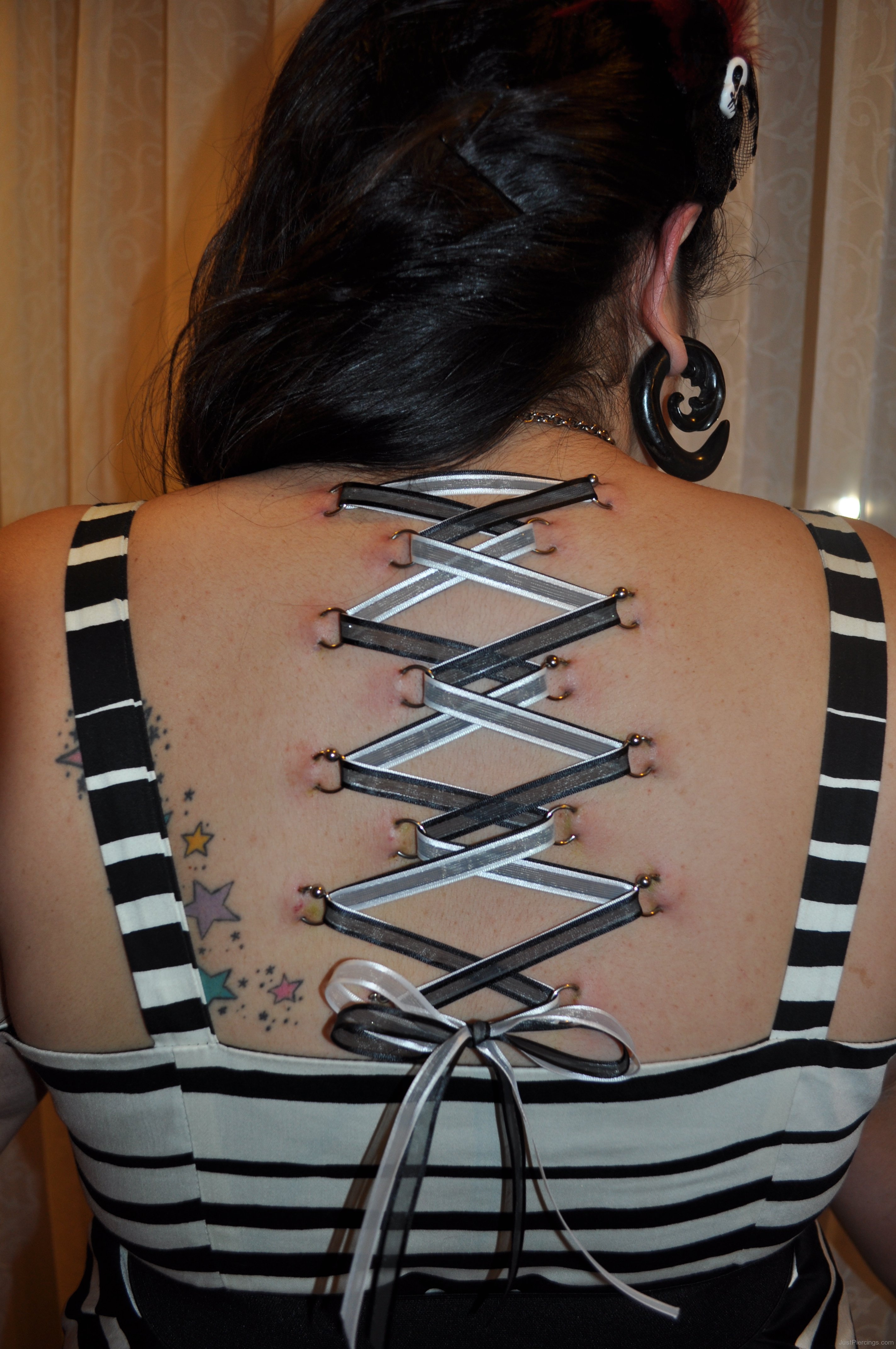Corset piercing has become one of the most intriguing and visually striking forms of body modification in recent years. This unique piercing style involves a series of piercings along the back or sides of the body, often connected by jewelry to create a laced-up corset-like appearance. If you're considering this bold and artistic form of self-expression, it's essential to understand what corset piercings entail, how they are done, and what to expect during the healing process. This guide will walk you through everything you need to know about corset piercings, from their history to aftercare tips, ensuring you make an informed decision.
As with any body modification, corset piercings require careful consideration and research. They are not only a fashion statement but also a commitment that demands proper care and maintenance. Whether you're drawn to the aesthetic appeal or the symbolic meaning behind corset piercings, understanding the risks, costs, and aftercare is crucial. This article will provide expert advice, authoritative insights, and trustworthy information to help you navigate the world of corset piercings confidently.
By the end of this guide, you'll have a comprehensive understanding of corset piercings, including their history, procedure, healing process, and potential risks. We'll also address frequently asked questions and provide practical tips to ensure your piercing experience is safe and satisfying. Let’s dive into the fascinating world of corset piercings and explore why they have captured the imagination of so many.
Read also:Morbius 2 Release Date
Table of Contents
- What is a Corset Piercing?
- History and Cultural Significance
- Procedure and Preparation
- Healing Process and Aftercare
- Potential Risks and Complications
- Costs and Maintenance
- Choosing the Right Jewelry
- FAQs About Corset Piercings
- Expert Tips and Recommendations
- Conclusion
What is a Corset Piercing?
A corset piercing is a decorative and artistic body modification that involves multiple piercings along the back or sides of the body, typically the lower back. These piercings are strategically placed in symmetrical rows, and jewelry is threaded through them to create a laced-up corset effect. The result is a visually stunning design that mimics the look of a traditional corset, complete with "laces" made of body jewelry.
Corset piercings are often temporary and are usually done for special occasions, photoshoots, or performances. However, some individuals choose to make them semi-permanent or permanent, depending on their preferences and lifestyle. The versatility of corset piercings allows for customization, with variations in the number of piercings, placement, and jewelry types.
Types of Corset Piercings
- Back Corset Piercing: The most common type, involving piercings along the lower back.
- Side Corset Piercing: Piercings placed along the sides of the torso.
- Waist Corset Piercing: Focuses on the waist area, creating a cinched effect.
History and Cultural Significance
The concept of corset piercings draws inspiration from the historical corset, a garment that has been worn for centuries to shape and accentuate the body. Corsets were popularized in the 16th century and became a symbol of femininity, elegance, and social status. The modern corset piercing pays homage to this tradition while offering a contemporary twist.
In the world of body modification, corset piercings gained popularity in the late 20th and early 21st centuries, particularly within alternative and subculture communities. They are often associated with self-expression, individuality, and artistic creativity. The piercing style has also been embraced by performers, models, and influencers, further cementing its place in popular culture.
Cultural Influences
- Fashion and Art: Corset piercings are often featured in avant-garde fashion shows and artistic photoshoots.
- Subculture Movements: Popular among gothic, punk, and alternative communities.
- Symbolism: Represents empowerment, transformation, and breaking societal norms.
Procedure and Preparation
Getting a corset piercing requires careful planning and preparation. The procedure involves multiple piercings, so it's essential to choose a reputable and experienced piercer. Before the session, discuss your design ideas, placement preferences, and jewelry options with your piercer to ensure the best results.
The piercing process typically involves the following steps:
Read also:Hozier
- Consultation: Discuss your goals and expectations with the piercer.
- Marking: The piercer will mark the placement of each piercing using a surgical pen.
- Piercing: Each hole is pierced using a sterilized needle, and jewelry is inserted.
- Final Touches: The piercer will ensure the jewelry is threaded correctly to create the desired corset effect.
Preparation Tips
- Research and select a certified and experienced piercer.
- Avoid alcohol and blood-thinning medications before the procedure.
- Wear loose, comfortable clothing to the appointment.
Healing Process and Aftercare
One of the most critical aspects of getting a corset piercing is understanding the healing process and practicing proper aftercare. Corset piercings can take several weeks to months to heal fully, depending on factors such as placement, individual healing rates, and aftercare practices.
During the healing period, it's essential to follow these aftercare tips:
- Clean the piercings daily with a saline solution or mild soap.
- Avoid touching or twisting the jewelry unnecessarily.
- Wear loose, breathable clothing to prevent irritation.
- Avoid swimming in pools, hot tubs, or natural bodies of water.
Signs of Infection
Be vigilant for signs of infection, such as redness, swelling, pus, or excessive pain. If you notice any of these symptoms, consult a healthcare professional immediately.
Potential Risks and Complications
Like any body modification, corset piercings come with potential risks and complications. These can include infection, scarring, allergic reactions, and migration of the jewelry. It's crucial to weigh the pros and cons before proceeding with the procedure.
To minimize risks, ensure you:
- Choose a reputable and experienced piercer.
- Follow all aftercare instructions diligently.
- Monitor the healing process and seek medical advice if needed.
Costs and Maintenance
The cost of a corset piercing can vary depending on factors such as the number of piercings, jewelry type, and location. On average, you can expect to pay between $50 and $150 per piercing. High-quality jewelry and additional aftercare products may also contribute to the overall cost.
Maintenance is another important consideration. Regular cleaning and inspections are necessary to ensure the piercings remain healthy and intact. If you plan to keep the corset piercing long-term, be prepared for ongoing maintenance and potential jewelry upgrades.
Choosing the Right Jewelry
Selecting the right jewelry is crucial for both aesthetics and comfort. Popular options for corset piercings include:
- Barbells: Ideal for secure placement and minimal movement.
- Captive Bead Rings: Offer a classic and decorative look.
- Threaded Jewelry: Allows for easy threading and customization.
Material Considerations
- Surgical Steel: Durable and hypoallergenic.
- Titanium: Lightweight and ideal for sensitive skin.
- Gold: Offers a luxurious and elegant appearance.
FAQs About Corset Piercings
Q: Does a corset piercing hurt?
A: Pain levels vary depending on pain tolerance and placement, but most people describe it as a sharp, brief sensation.
Q: How long does it take to heal?
A: Healing times can range from 6 weeks to several months, depending on individual factors.
Q: Can I remove the jewelry during healing?
A: It's not recommended to remove the jewelry until the piercings are fully healed to avoid closure or complications.
Expert Tips and Recommendations
To ensure a successful corset piercing experience, consider the following expert tips:
- Research thoroughly and choose a piercer with a strong portfolio of corset piercings.
- Discuss your design ideas and expectations in detail during the consultation.
- Invest in high-quality jewelry to reduce the risk of irritation or allergic reactions.
- Be patient during the healing process and avoid rushing into changes or removals.
Conclusion
Corset piercings are a bold and artistic form of self-expression that can transform your look and make a powerful statement. By understanding the procedure, healing process, and potential risks, you can make an informed decision and enjoy a safe and satisfying piercing experience. Remember to prioritize aftercare, choose high-quality jewelry, and consult with a trusted piercer to achieve the best results.
We hope this guide has provided you with valuable insights into the world of corset piercings. If you found this article helpful, feel free to share it with others who may be interested. For more information on body modifications and piercing trends, explore our other articles and resources. Your journey to self-expression starts here!

